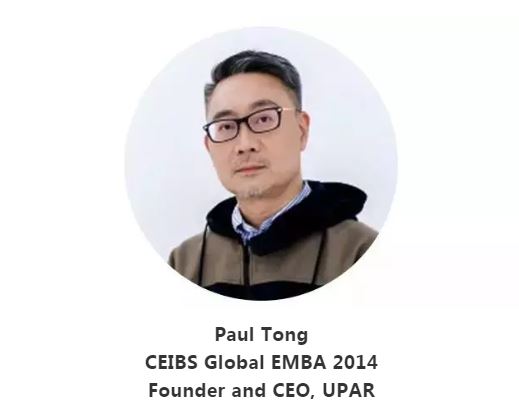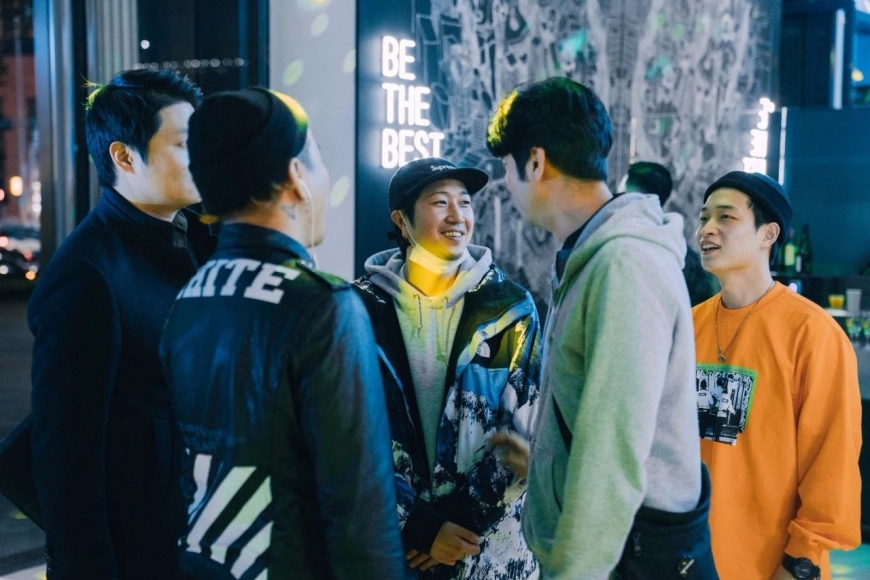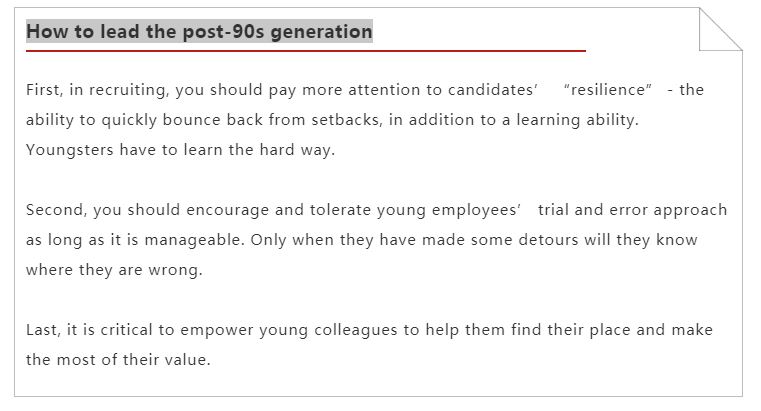To Get People “Up and Running”
Click Here to Read More Alumni Stories
Three years ago, Paul Tong, aged 52, and four other sports-loving friends established the UPAR brand for sports, fashion and lifestyle. At the end of 2018, UPAR's first flagship store opened in the city of Shenzhen. "If you plant seeds today, you can't reap a harvest immediately, but you will be rewarded in the future," said the fashion retailer, who has worked in the garment industry for 30 years.

Paul Tong has had a stellar career.
In 1989, he enrolled in the Fashion Institute of Technology in New York (FIT), with a Major in Fashion Design. In the same year, he was honoured as one of the "15 most talented young designers in the US" by Ideacomo, Italy.
Between 2000 and 2010, he served successively as Vice President, Fashion Division at ImagineX Group, responsible for the operations of world-renowned brands like Versace, Dolce & Gabbana, Hugo Boss, and Donna Karan, before moving on to become General Manager of Gucci Greater China in 2010.
Five years after leaving Gucci, Tong set out on an entrepreneurial journey and founded UPAR in partnership with his friends. The first flagship store drew an array of trend-spotters, including Edison Chen, Clara Lee and Kazuki Kuraishi, to its opening.
Less than half a year after its opening, UPAR organized a series of running activities and established a runners' community titled "Team UPAR" (UPAR = Up And Running), and has been leading the trends in combining sports, lifestyle and fashion.

On the day of the interview, Tong wore a UPAR T-shirt. Despite being over 50, Tong has remained in excellent fitness, due to years of regular exercise. Looking back on his career over the decades, he said "So far, everything has been going smoothly, despite some obstacles in the way. Compared with others, I'm quite lucky."
Each step I take will get me closer to my goal.
In fact, UPAR is not his first startup.
After graduating from FIT in 1990, Tong worked for a US casual wear brand for six years. When some European and American garment brands began shifting their focus onto the Asian market, his company set about opening a representative office in Hong Kong. As a native Hong Kongese, Tong was sent back to Hong Kong to tap into the Mainland Chinese market.
When recalling that experience, he shared an intriguing detail. When paying a visit to a well-known local store called Guiyou during his first tour to Beijing in 1994, he was deeply impressed by the display: inside the glass cabinets lined up on the dimly-lit ground floor, men's trousers were hanging upside down, with the trouser bottoms tucked in.

"This display brought convenience not only to customers, but to salespersons. When my boss asked me about the consumer market in Mainland China, I replied that there was huge potential in this market," Tong recalled. It was at that time that he set his sights on the Mainland market.
Although this profession provided him with ample space for career development, Tong had a long-cherished dream of building his own brand to bring his design skills to the fore. In 1996, he left the company to create an upscale ready-to-wear brand on his own.
At that time, Tong was targeting the markets in Taiwan and Singapore. In the 1980s, these two economies, coupled with Hong Kong (SAR) and South Korea, were known as the "Four Asian Tigers", as their dizzying economic growth made them the most affluent economies in Asia. Tong's upscale ready-to-wear brand had a strong presence in Taiwan and Singapore.
Unfortunately, many of his customers were scared off by the Asian financial crisis that broke out in 1997.
"A lot of money could not be paid back, so I had no choice but to shut down my company and seek a new opportunity."
A chain brand in Hong Kong hired Tong as an Assistant General Manager in the hopes that he would help the company expand into the Southeast Asian market. Before long, Tong realized that the company chose him mainly because of his entrepreneurial experience and knowledge of cost control and design enabled him to strike a balance among departments. "The company wants you to be not only a professional manager, but also an entrepreneur."
This experience has taught him a valuable lesson: "If you plant seeds today, you can't reap a harvest immediately, but you will be rewarded in the future."
"Everything that happens has a cause and effect. Without what happened before, there would be no next step at all."
Success is all about the right person in the right place at the right time.
In 2000, Tong joined ImagineX, responsible for its operations in the mainland market. "This is a dynamic business. My job title was changed six times within eight years. When serving different brands, I felt like serving different companies. For example, the corporate culture of Hugo Boss reflects Germans' rigor, while that of DKNY embodies Americans' overflowing enthusiasm and forward thinking. This job gave me an opportunity to experience different roles."
A few years later, he was promoted to Vice President of the Fashion Division, taking the helm of all emerging and niche brands. "It's akin to incubation," he said, "These brands are new entrants to the market. We needed to marshal more resources to advance their development." This was yet another entrepreneurial experience.
Stone Island, an Italian premium brand for functional sportswear that has taken the fashion circle by storm in recent years, was introduced into China by Tong and his team. However, Chinese people did not seem to embrace the punk style a decade ago. This brand did not catch on in China until 2014, when it rolled out collaborations with the leading streetwear brand Supreme.
"In hindsight, success is all about the right person in the right place at the right time and nothing else," he concluded.
Joining Gucci, and then going back to school
Tong began as General Manager of Gucci Greater China in August 2010. During his term of more than three years, he witnessed Gucci's all-time sales peak and then slump in China.
He noted that the period from 2003 to 2012 was a golden decade for luxury brands in China. Especially in the final five years of that period, brands experienced explosive growth, with the store count hitting a new high every year. Greater China accounted for about one-quarter of Gucci's global sales. Later though, luxury brands underwent a major dip in sales.
Luxury brands used to make sales forecasts and preparations one year in advance for a spending spree every October. He recalled that in 2012, however, the sales boom didn't come as expected, not just for Gucci, but for other brands as well.

Gucci headquarters held him responsible for the sales slide and eventually he resigned to start his own retail-focused consulting business. Meanwhile, he considered going back to school.
His experience at Gucci made him keenly aware of the particularities in the Chinese market. He thought a full understanding of the culture and rules of this market would help him to avoid unnecessary detours in the future.
"This was why I chose to attend CEIBS Global EMBA in 2014, instead of going back to Hong Kong or elsewhere," he explained.
He admitted that he had self-doubts. After all, as a designer-turned-entrepreneur, he lacked a systematic business education.
His 20-month study at CEIBS was a transformative experience. "Each session contained intensive case studies. I was familiar with some industries, while others were completely unrelated to my background. The most important thing was that I learned to draw lessons from business successes and failures across a spectrum of industries and apply them to my work, and keep myself alert," he said. He still keeps some learning materials. What he learnt at class has been put into practice.
An Alternative Approach to New Retail
In 2016, he started another new business. Together with four like-minded sports enthusiasts, he decided to create the fashion and sports brand "UPAR" to get people "up and running".
It has been 20 years since he first started his own business. He makes no secret that he is fulfilling his dreams of building his own brand, a dream that was left unfinished 20 years ago, and combining running with fashion, out of his love for sports. No matter how busy he is, he makes sure he does exercise at least two or three times a week.
"Retail is part of UPAR, but we are more than just a garment brand. Garments serve as the medium through which we get our ideas across. We want to inspire more people to run," he said. For him, UPAR conveys an attitude toward life.
The UPAR flagship store in Shenzhen can be divided into four areas: a retail area, a café, an art zone, and a running station. At the store, customers can buy sports gear, have their belongings stored before exercise, take a shower in a five-star bathroom after exercise, and unwind and enjoy themselves in the café and art zone.

"The flagship store delivers consumers a closed-loop experience," he said. Since its opening, UPAR has regularly organized weekly running, and monthly running on the themes of salad and beer, and started operating a runners' community. Presently, UPAR is improving its online mall.
The combination of offline experience, an online platform, and community operations easily reminds people of the "new retail" concept that has caught on in recent years. But UPAR has tried a different tactic, the most striking difference being that UPAR has chosen to start offline.
"If you follow the current business logic, you have to go online first," he said, "But from my experience, the costs of online operations are no lower than those of offline operations."
"When starting offline first, we also faced considerable operating costs. However, what lies at the heart of our brand is human-to-human communication and connection. The stickiness cannot be achieved through an online ecosystem."
He admitted that UPAR chose a tough but necessary road. At this point, he said half-jokingly that his engagement in offline operations would give him an extra edge.
The Future Belongs to Youngsters
Since its opening, the data from the UPAR flagship store in Shenzhen has revealed that the user groups are predominantly in the 20-30 (46%) and 30-40 (42%) age brackets. Tong's colleagues were mostly born in the 1990s.
When it comes to dealing with the younger generation, especially the post-90s generation, he shared three tips:

"My children are both millennials, and I can get to know youngsters through them," he smiled, "We believe they will grow up. The world is their oyster. Let's come down off our high horse."
With this mentality, this fashion retailer, with over 30 years of experience in the fashion field, stays sober and calm. "Changes are unfolding at the speed of light. I constantly remind myself that I must adapt to changes and draw on past experience without being its slave during decision-making."
At the end of the interview, Tong shared his vision for UPAR. "We want to build it into an international company and a world-class brand."
While data revealed that 97% of brands end in failure, he quoted John F. Kennedy as saying, "We choose to go to the Moon in this decade and do the other things, not because they are easy, but because they are hard."
"It's not easy to build a brand. Despite difficulties along the way, we must forge ahead to keep our brand going," he said.














